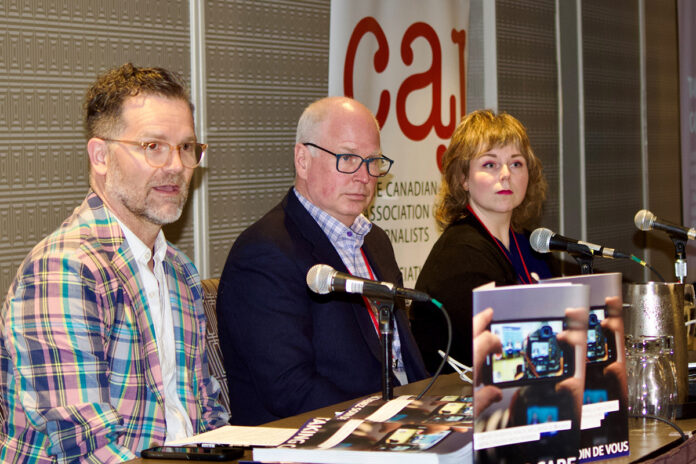
WARNING: SUICIDE
This article contains mention of suicide. If you or someone you know is struggling with their mental health, contact the Mental Health Crisis Line: 613-722-6914 (within Ottawa) and 1-866-996-0991 (outside Ottawa), the Ottawa Distress Centre Crisis Line: 613-238-3311, or the Youth Services Bureau 24/7 Crisis Line: 613-260-2360 or 1-877-377-7775 (toll)
More than half of Canadian journalists are currently experiencing more stress than ever before, according to a report published by The Canadian Journalism Forum on Violence and Trauma and Carleton University.
The report, titled Taking Care, provides comprehensive data on mental health in the news industry, including harassment, exposure to trauma and alcohol use. The report was written by Carleton University School of Journalism and Communication instructor Matthew Pearson, CBC reporter Dave Seglins, freelance journalist Tracey Lindeman and Carleton journalism alumna Cassandra Yanez-Leyton.
More than 1,000 journalists participated in the 20-minute anonymous online survey between Nov. 1 and Dec. 18, 2021.
More than half of participants reported seeking medical help to deal with work-related stress, 80 per cent suffered burnout and one in 10 reported having considered suicide after covering traumatic stories.
Pearson said a lack of data on journalists’ mental health motivated the team to start the study.
“We knew that there had been research done in other countries and so we decided to create a survey in Canada so that we could really track the experiences of Canadian journalists,” he said.
A study on the mental health of Pakistani journalists revealed “moderately elevated” levels of depression and “severely elevated” levels of anxiety among respondents when compared to the general population. A report on the mental health of international journalists reporting on COVID-19 showed around 70 per cent suffer from some levels of psychological distress and 26 per cent have clinically significant levels of anxiety.
Taking Care found 28 per cent of media workers were diagnosed with anxiety and 21 per cent with depression—a stark contrast to the 2.6 per cent of Canadians diagnosed with anxiety and 4.7 per cent with depression.
Possible reasons listed for these findings include a “suck it up” culture, threats toward journalists and the psychological effects of covering traumatic events.
Despite these results, 85 per cent of journalists have never received training on managing their mental health at work. Almost none received training for reporting on traumatic events, despite their high likelihood of exposure to them. According to the report, 91 per cent of editorial and production assistants had worked on murder coverage in the past four years.
Pearson, who teaches a workshop for trauma-informed reporting as part of a class he teaches at Carleton, said he hopes this report will reduce the stigma of mental health challenges for current and future journalists.
“What was maintained in newsrooms about having a stiff upper lip or a sort of ‘suck it up’ mentality also trickled down to [the] journalism program, and I think what we’re seeing is that we cannot do that anymore,” he said.
Pearson’s workshop focuses on both approaching sources carefully and managing one’s own mental health while covering traumatic stories. Izzie Stephenson,* a third-year journalism student who took the workshop, said it was the only direct mental health training she has received at Carleton.
“Navigating high-stress stories with assault cases or accidents or anything, that’s really stressful for you as a journalist—as well as obviously the people involved,” Stephenson said.
While most respondents were white and from Ontario, Pearson said the results would have been more nuanced with a more diverse sample size.
“If the conclusion of a survey like this—which was completed by a majority of people who are white, who are cisgender, who are straight—produce[s] the results that we have, I think we can safely add that the experience is that much more challenging for people who are the most marginalized,” Pearson said.
Women made up 59 per cent of the survey’s demographic and reported feeling more stress than their male colleagues.
Nadine Yousif,* Carleton journalism alumna and mental health reporter for the Toronto Star, said she experienced a serious dip in her mental health last year after being attacked on social media.
“[Online harassment is] a lot worse for women of colour because you know, the nature of the attacks—it can get misogynistic [and] racist.”
Yousif said she was lucky to have supportive managers, but journalists aren’t always afforded the luxury of stepping away from social media.
“I think that a lot of newsrooms definitely should be prioritizing making sure that their employed employees have access to mental health benefits therapy,” Yousif said.
The report outlines nine suggestions for newsrooms to support media workers. Some of the recommendations echo Yousif’s suggestions, such as more mental health benefits, improved education on the science of well-being and peer-support group systems.
Despite the results, both Yousif and Stephenson see a future for wellness in journalism.
“At my lowest points, it’s been that deeper desire to help people—that deeper desire to bring information forward to make our community more informed—that has really kept me going,” Yousif said. “It’s important that we don’t lose sight of why we’re here in the first place.”
*Izzie Stephenson has contributed to the Charlatan
*Nadine Yousif is a former Editor-in-Chief of the Charlatan
Featured image provided by Matthew Pearson.





